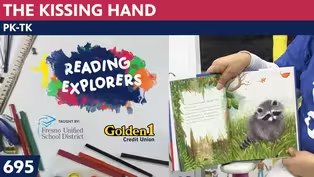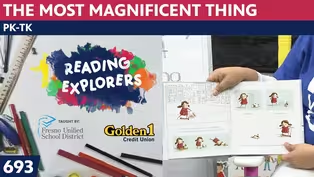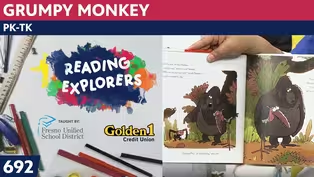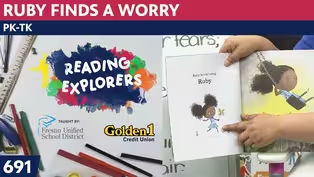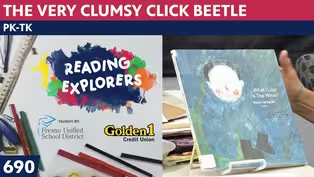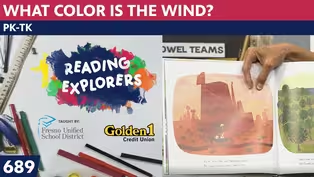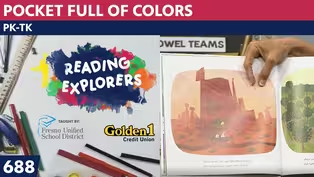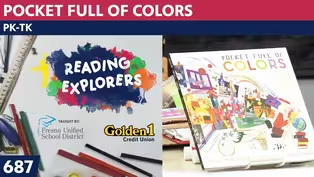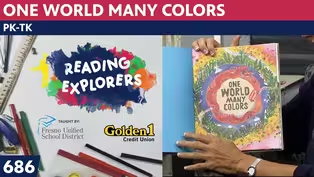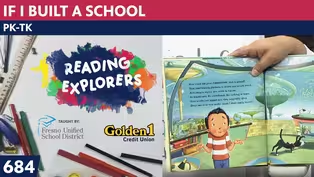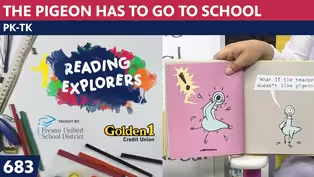
TK-374: Marc Chagall - Fish on a Vintage Poster
Season 3 Episode 415 | 14m 12sVideo has Closed Captions
Today's art is a Fish on a Vintage Poster
Join me today as we continue our study of one of my favorite artists, Marc Chagall.. Each day we will enjoy a Chagall masterpiece that shows his dreamlike art. Today's art is a fish on a vintage poster. We will create art using one of the symbols associated with Chagall...a FISH!!
Problems playing video? | Closed Captioning Feedback
Problems playing video? | Closed Captioning Feedback
Reading Explorers is a local public television program presented by Valley PBS

TK-374: Marc Chagall - Fish on a Vintage Poster
Season 3 Episode 415 | 14m 12sVideo has Closed Captions
Join me today as we continue our study of one of my favorite artists, Marc Chagall.. Each day we will enjoy a Chagall masterpiece that shows his dreamlike art. Today's art is a fish on a vintage poster. We will create art using one of the symbols associated with Chagall...a FISH!!
Problems playing video? | Closed Captioning Feedback
How to Watch Reading Explorers
Reading Explorers is available to stream on pbs.org and the free PBS App, available on iPhone, Apple TV, Android TV, Android smartphones, Amazon Fire TV, Amazon Fire Tablet, Roku, Samsung Smart TV, and Vizio.
Providing Support for PBS.org
Learn Moreabout PBS online sponsorshipMore from This Collection
Valley PBS and Fresno Unified School District have partnered with Golden 1 Credit Union to create Reading Explorers Lessons for grades Pre-Kindergarten through Third grade. The daily lessons will be taught by Fresno Unified School District teachers and are created to help students practice their reading skills and reinforce lessons during distance learning.
Video has Closed Captions
Valley PBS presents Reading Explorers Lessons for Pre-Kindergarten and TK. (26m 27s)
PK-TK-693-The Most Magnificent Thing
Video has Closed Captions
Valley PBS presents Reading Explorers Lessons for Pre-Kindergarten and TK. (26m 26s)
Video has Closed Captions
Valley PBS presents Reading Explorers Lessons for Pre-Kindergarten and TK. (26m 28s)
Video has Closed Captions
Valley PBS presents Reading Explorers Lessons for Pre-Kindergarten and TK. (26m 28s)
PK-TK-690: The Very Clumsy Click Beetle
Video has Closed Captions
Valley PBS presents Reading Explorers Lessons for Pre-Kindergarten and TK. (26m 22s)
PK-TK-689: What Color is the Wind?
Video has Closed Captions
Valley PBS presents Reading Explorers Lessons for Pre-Kindergarten and TK. (26m 21s)
PK-TK-688: Pocket Full of Colors
Video has Closed Captions
Valley PBS presents Reading Explorers Lessons for Pre-Kindergarten and TK. (25m 58s)
PK-TK-687: Dancing Through Fields of Colors
Video has Closed Captions
Valley PBS presents Reading Explorers Lessons for Pre-Kindergarten and TK. (26m 20s)
PK-TK-686: One World Many Colors
Video has Closed Captions
Valley PBS presents Reading Explorers Lessons for Pre-Kindergarten and TK. (27m 13s)
PK-TK-685: School is Wherever I am
Video has Closed Captions
Valley PBS presents Reading Explorers Lessons for Pre-Kindergarten and TK. (26m 32s)
PK-TK-684: If I Built a School
Video has Closed Captions
Valley PBS presents Reading Explorers Lessons for Pre-Kindergarten and TK. (26m 21s)
PK-TK-683: The Pigeon Has to Go to School
Video has Closed Captions
Valley PBS presents Reading Explorers Lessons for Pre-Kindergarten and TK. (26m 22s)
Providing Support for PBS.org
Learn Moreabout PBS online sponsorship♪ Good morning to a brand new day ♪ ♪ Time to learn and the games to play ♪ ♪ Learning things is so much fun ♪ ♪ Learning is good for everyone ♪ (guitar playing) (playful music) - Hello, early learners.
And welcome back to the art room where we are studying my favorite artist, Marc Chagall.
Let's start out with our hello song.
♪ Hello Nice to see you everyone ♪ ♪ Hello nice to see you everyone ♪ ♪ Hello to you ♪ ♪ Hello to you ♪ ♪ Hello to you ♪ ♪ Hello to me ♪ ♪ Hello nice to see you everyone ♪ Now, Marc Chagall.
Wasn't always my favorite artist but when I wrote the art curriculum for Fresno unified I chose this book called ""Journey on a Cloud " And "Journey on a Cloud " is the book we bought for all of our TK teachers So they could read this book.
So before I told them the things that I would do I opened the book on my couch and I looked through this book and I looked at it for two hours.
Two hours with one book, and I'll tell you why.
And it's what made me love Marc Chagall because this has inspired.
The author saw the paintings of Marc Chagall and they thought there's a story we could write and one of the women wrote the book and the other one did the artwork.
And we know how long it takes us to do the artwork.
And this book goes through many pages but I wanted to show you what they did.
The story is about Zephyr, who is a mailman and he lives in a blue town and it's all the streets are named after colors of blue.
If you go to a paint store and they gave you a paint chip if you're going to paint at home and it has really pretty names for the colors like one of the orange ones said sunset over Hawaii.
And one of the ones that I picked had lupine blue and lupine is a kind of flower that I could picture right away what that color would look like.
But they know that Marc Chagall did funny things and they made a village and the village is made out of fish shapes.
The roof here on this one is a fish.
This one the roof is a fish.
The tree of this tree is made out of a fish.
On the next page, his whole house here's the head of the fish, the decorations on the house are the scales of the fish, the eye of the fish and the smile of the fish gets incorporated into the house or made into the house.
On this next page, the village has a fish as this roof a fish as this roof, a fish as this roof the scales of the fish are the shingles on this roof.
And I thought, how funny?
And here's a goat They knew that Marc Chagall loved goats so they even added it to the artwork.
So the art that we're looking at today, which is inspired by this book, but it's also using an old poster.
Let's take a look at the easel at the poster that Marc Chagall painted.
Now, he didn't paint this for the exhibition but this was for a poster, a magical exhibition poster that is called Time is a River Without Banks.
Now we know banks as a place where you keep money but the banks of a river is the edge of the river.
So here's the bank of the river.
Here's the bank of the river and here's the river in between.
Now this is part of a clock.
You can see, this is the tick tock, tick tock of the clock.
And the clock itself must be hidden behind this fish's body.
Now we know that Marc Chagall also did violins.
And in this picture, the fish is playing a violin.
We know that Marc Chagall loved his wife Bella so much that he included her in many of his paintings.
And here they say, this is Marc Chagall on the bank of the river with Bella and their little baby.
They had a child together.
And then in the back is the village.
But what I thought we could do is use the paper that we painted for Monet and cut it into a fish shape and make it into an interesting fish by putting a good face on it.
Maybe we can cut and paste some things.
Maybe we can use our pastels.
You can tell yourself what you want to do.
I don't plan to put the wings on my fish.
I'm going to cut out a few different fish and add them because I might end up putting it on a piece of background paper.
So let's take a look at the paper from last week, here I have all of my papers.
Let me pick up my table and show you about this.
Come up table.
well, I'm getting stronger every day that used to be hard.
Now it's not so hard for me.
I'll move this aside although it does have that little picture of a fish I have.
When I write the lessons, I put the picture of the artist.
I tell about them and put it on my clipboard.
Tell a little about the picture and then put the picture in there.
And then all down below, I put down what I need to remind you to bring for tomorrow but let's move the pointer stick 'cause we don't need it anymore.
You'll be excited to know remember when we did Klimt and I bought some golden paint at that store and it's not the one where everything's a dollar they didn't have it there but this one they had at the store near my house.
And I decided I didn't want to use gold paint.
I'm going to use silver because I thought that fish's scales looked more silvery than gold but you can use whatever you want.
And if you don't have the paint you can get your gold or silver crayon out.
So look at each of these and I think each of these would make a beautiful fish.
I'm gonna start out with this one though.
And when I look at the shape if you think it's easier to draw it on your paper before you cut it out, you can do that.
And I'm going to show you a couple of ways that you could do it.
Now to do the fish, I'm gonna leave a place because he always made his fish have kind of big lips.
So it has a long skinny body and its tail can go to the end.
Do you see this?
That's the top of my fish.
Now, he makes the lips look like a human's lips even though a fish doesn't really have human lips but I'm going to do it like his 'cause I'm being inspired by his great artwork.
Now, normally I would not draw before I cut.
I'm a person who can just start out by cutting.
But for us that are still just beginning to be good artists I'm showing you how I'm doing this.
So I'm cutting out one and I'm thinking I made his body a little fatter than I want to so I can trim it after I look at it on the other side and see if I like it.
So I'm cutting out my fish, looking at it and I think Oh, it needs some fins.
And I probably should have just kept it the same as the paper that I'm cutting.
So the next one I'll show you what I mean but I did bring a glue stick so if I want to put the fins on him I could use a different color.
Let me move these over so you can see it a little better.
Here's a scrap from Monet's water, Lily pond.
And I'm gonna keep these scraps 'cause you know I'll use them for something else, but here's my fish shape.
But I think it really does need some fins to help it direct it's way as it's swimming along.
So I am going to put this one at the top and have that little triangle up there.
So I'll put my glue stick on there and apply it because I may want to put silver on it too.
So I wanna make sure all the pieces are on here.
I'm gonna put another one down below maybe it'll make it a green one.
it can help it find its way 'cause they have to navigate they just can't keep a skinny body without something to make its turns.
So that's what the fins can do.
Now let's see how that looks.
Oh, much better.
Now do I like it this fat?
Yes.
Now I have my white pen.
I think I'm going to do, I'll outline it's eye first and I'll put another one inside.
and fish don't have the same kind of eyes that humans or mammals have but I'm gonna make his eye be a little shiny white.
I think that makes it look pretty good.
And I'm going to outline its lips and I'll fill it in with another color, but I'll let that ink dry a little bit.
Oh, it's lips are kind of like a heart.
Now to get my silver paint and think about the design I would like to make for it scales.
And I'm not really sure yet because I haven't done this project before and I didn't even practice it at home like I sometimes do, 'cause I think now what are gonna be some things that might be a problem?
It's Oh, this looks good.
So I'm putting the scales on.
Now normally you might pour your paint into a little container but since I don't have to share it with anyone I'm going to just keep mine like this.
And what I'm doing is just putting some kind of like a letter C back to myself.
It's looking backwards, I think to you but I'm going to put these scales on here to make sure that I have some shiny places and make it look beautiful because I wanted to add a few of them because I had told you how I plan to mount them.
I'm going to have a piece of blue paper and have them a school of fish maybe swimming across and I'll put a few fish across and make it look really pretty that way.
But you can see how I've got my silver paint.
And sometimes I just use what's in the lid 'cause this paint, I think I paid $2 and 79 cents for it.
So if you save up your money and say to your family how can I earn money to pay for my art supplies?
And you say Oh, it only costs $2 and 79 cents.
And when I want more in the lid, I make sure the lid is on super tight and I shake it and it gets into the lid and then I can just use that as my palette.
I'm popping the bubble that's on the top.
And I might put a little dot, Oh that looks pretty good too.
If I put a little dot in the middle of my C shape it makes it look like a pattern a design pattern that I might like even more than just having it, just plain.
Still I'm doing these dots in here.
And I do like on the fish's tail that you show that it has kind of rigid areas for them to swim with.
I'm doing this one and here and I can do some little on its fins.
I'm liking this pretty much boys and girls.
I hope you are too.
I might just do some dots.
I can make this kind of follow along with Klimt how he would do his spirals and his dots and his decorations.
I really like this fish I hope that you're liking yours too.
And I can make things bigger and smaller.
I can make two and then put one in between kind of like we do when we line up and children want to see where they're going to be working.
We put two people and then you say make a window and the two people make room for someone to get in between.
Now, tomorrow we're going to be doing a picture that's through a window.
And a while back, we did one that we saw through the window to the ocean below.
And this one we're going to look out to Paris and Paris has the Eiffel tower.
So overnight, if you look at the Eiffel tower and get an idea of what the shape is I think you will have an easier time of making an Eiffel tower.
If you choose to put the tower in your picture, I'm not sure if everyone will want to do the same thing that I'm doing but you'll need to bring your coloring tools.
A piece of white paper I'm bringing some little skinny pieces to make a frame of a window.
I'm going to bring a pencil and a pen.
And maybe even some of this paper that I'm using today I'm going to use water color to do the background.
So I will see you tomorrow.
As we do Paris through the window, goodbye boys and girls.
(guitar playing) ♪ Good morning to a brand new day ♪ ♪ Time to learn and games to play ♪ ♪ Learning things is so much fun ♪ ♪Learning is good for everyone ♪ (guitar playing)
Support for PBS provided by:
Reading Explorers is a local public television program presented by Valley PBS
